Effective Communication Management and Team Leadership in Projects
VerifiedAdded on 2021/09/16
|12
|2437
|341
Report
AI Summary
This report delves into the critical aspects of communication management and team leadership within the context of multicultural project environments. It highlights the significance of effective project management in today's competitive market, emphasizing the need for versatile strategies to address dynamic customer requirements. The report explores the challenges faced by project managers in multicultural settings, including language barriers, cultural differences, and communication gaps. It discusses the impact of these factors on team dynamics and project outcomes, providing practical recommendations for overcoming such issues. The report covers key concepts such as cultural diversity, communication strategies, and leadership techniques, offering insights into how project managers can effectively lead cross-cultural virtual teams. It also addresses the challenges of virtual teams and provides advice on fostering effective communication, critical thinking, and problem-solving skills. The report concludes by emphasizing the importance of understanding cultural nuances, implementing training programs, and adopting ethical and social considerations to ensure project success.
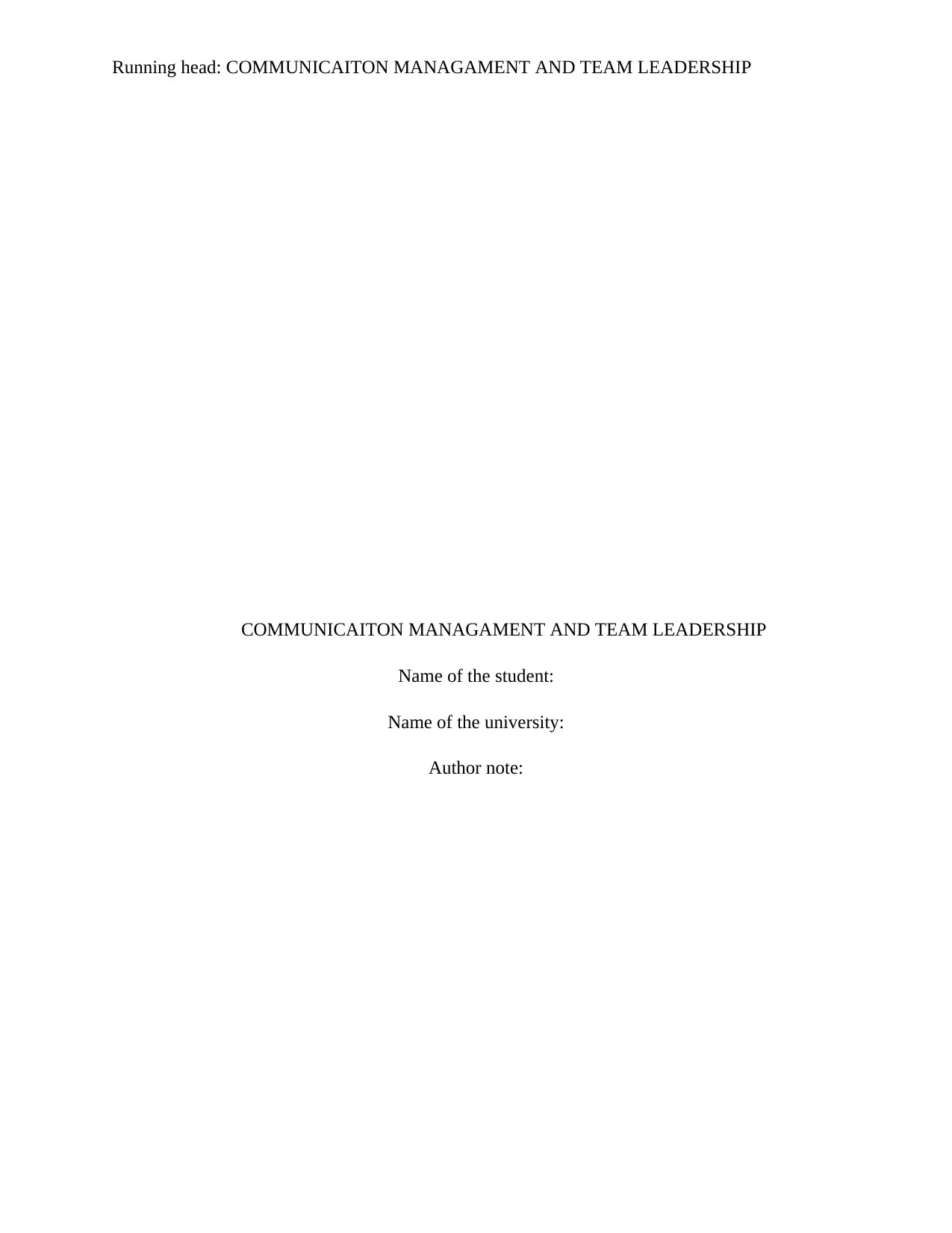
Running head: COMMUNICAITON MANAGAMENT AND TEAM LEADERSHIP
COMMUNICAITON MANAGAMENT AND TEAM LEADERSHIP
Name of the student:
Name of the university:
Author note:
COMMUNICAITON MANAGAMENT AND TEAM LEADERSHIP
Name of the student:
Name of the university:
Author note:
Paraphrase This Document
Need a fresh take? Get an instant paraphrase of this document with our AI Paraphraser
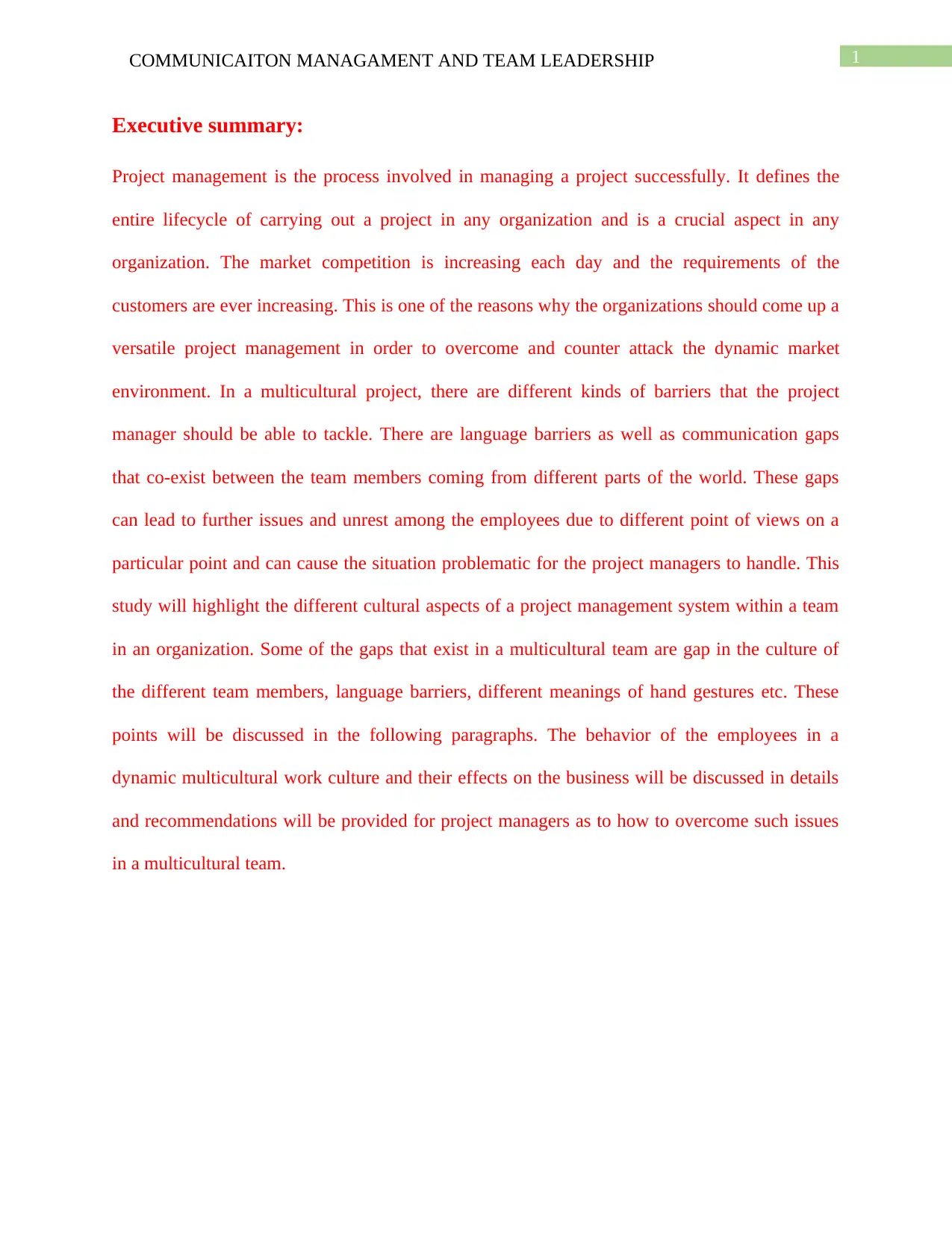
1COMMUNICAITON MANAGAMENT AND TEAM LEADERSHIP
Executive summary:
Project management is the process involved in managing a project successfully. It defines the
entire lifecycle of carrying out a project in any organization and is a crucial aspect in any
organization. The market competition is increasing each day and the requirements of the
customers are ever increasing. This is one of the reasons why the organizations should come up a
versatile project management in order to overcome and counter attack the dynamic market
environment. In a multicultural project, there are different kinds of barriers that the project
manager should be able to tackle. There are language barriers as well as communication gaps
that co-exist between the team members coming from different parts of the world. These gaps
can lead to further issues and unrest among the employees due to different point of views on a
particular point and can cause the situation problematic for the project managers to handle. This
study will highlight the different cultural aspects of a project management system within a team
in an organization. Some of the gaps that exist in a multicultural team are gap in the culture of
the different team members, language barriers, different meanings of hand gestures etc. These
points will be discussed in the following paragraphs. The behavior of the employees in a
dynamic multicultural work culture and their effects on the business will be discussed in details
and recommendations will be provided for project managers as to how to overcome such issues
in a multicultural team.
Executive summary:
Project management is the process involved in managing a project successfully. It defines the
entire lifecycle of carrying out a project in any organization and is a crucial aspect in any
organization. The market competition is increasing each day and the requirements of the
customers are ever increasing. This is one of the reasons why the organizations should come up a
versatile project management in order to overcome and counter attack the dynamic market
environment. In a multicultural project, there are different kinds of barriers that the project
manager should be able to tackle. There are language barriers as well as communication gaps
that co-exist between the team members coming from different parts of the world. These gaps
can lead to further issues and unrest among the employees due to different point of views on a
particular point and can cause the situation problematic for the project managers to handle. This
study will highlight the different cultural aspects of a project management system within a team
in an organization. Some of the gaps that exist in a multicultural team are gap in the culture of
the different team members, language barriers, different meanings of hand gestures etc. These
points will be discussed in the following paragraphs. The behavior of the employees in a
dynamic multicultural work culture and their effects on the business will be discussed in details
and recommendations will be provided for project managers as to how to overcome such issues
in a multicultural team.
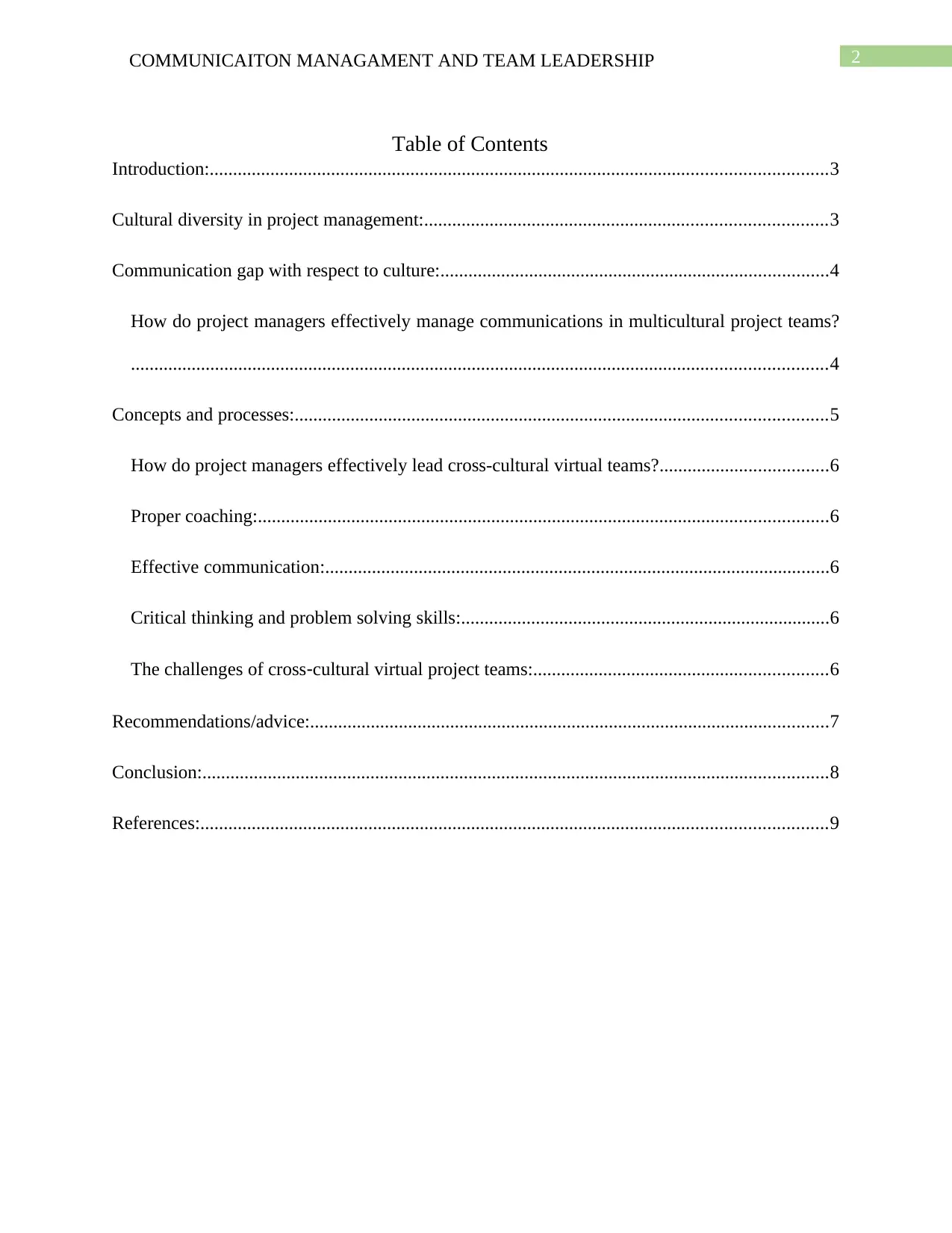
2COMMUNICAITON MANAGAMENT AND TEAM LEADERSHIP
Table of Contents
Introduction:....................................................................................................................................3
Cultural diversity in project management:......................................................................................3
Communication gap with respect to culture:...................................................................................4
How do project managers effectively manage communications in multicultural project teams?
.....................................................................................................................................................4
Concepts and processes:..................................................................................................................5
How do project managers effectively lead cross-cultural virtual teams?....................................6
Proper coaching:..........................................................................................................................6
Effective communication:............................................................................................................6
Critical thinking and problem solving skills:...............................................................................6
The challenges of cross‐cultural virtual project teams:...............................................................6
Recommendations/advice:...............................................................................................................7
Conclusion:......................................................................................................................................8
References:......................................................................................................................................9
Table of Contents
Introduction:....................................................................................................................................3
Cultural diversity in project management:......................................................................................3
Communication gap with respect to culture:...................................................................................4
How do project managers effectively manage communications in multicultural project teams?
.....................................................................................................................................................4
Concepts and processes:..................................................................................................................5
How do project managers effectively lead cross-cultural virtual teams?....................................6
Proper coaching:..........................................................................................................................6
Effective communication:............................................................................................................6
Critical thinking and problem solving skills:...............................................................................6
The challenges of cross‐cultural virtual project teams:...............................................................6
Recommendations/advice:...............................................................................................................7
Conclusion:......................................................................................................................................8
References:......................................................................................................................................9
⊘ This is a preview!⊘
Do you want full access?
Subscribe today to unlock all pages.

Trusted by 1+ million students worldwide
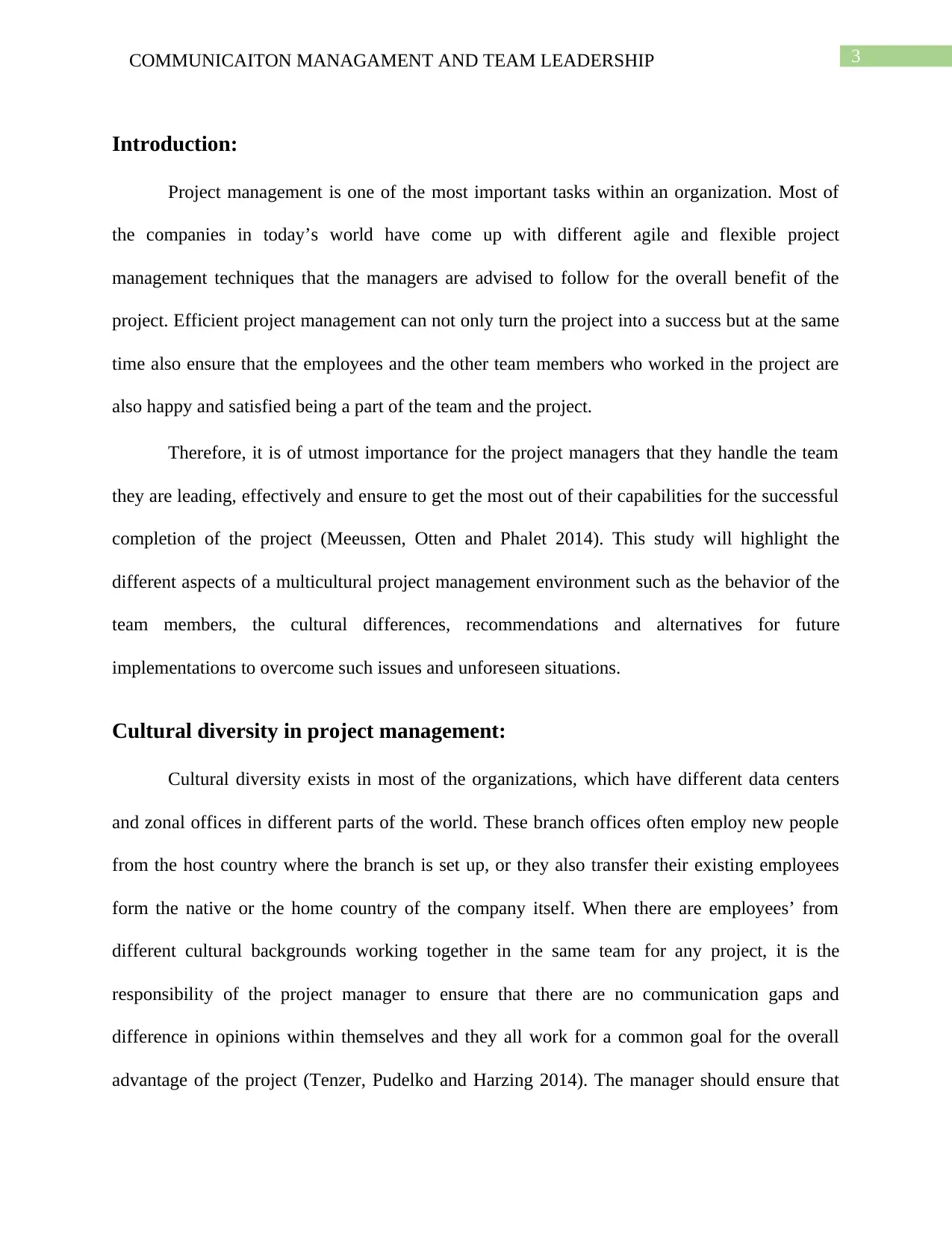
3COMMUNICAITON MANAGAMENT AND TEAM LEADERSHIP
Introduction:
Project management is one of the most important tasks within an organization. Most of
the companies in today’s world have come up with different agile and flexible project
management techniques that the managers are advised to follow for the overall benefit of the
project. Efficient project management can not only turn the project into a success but at the same
time also ensure that the employees and the other team members who worked in the project are
also happy and satisfied being a part of the team and the project.
Therefore, it is of utmost importance for the project managers that they handle the team
they are leading, effectively and ensure to get the most out of their capabilities for the successful
completion of the project (Meeussen, Otten and Phalet 2014). This study will highlight the
different aspects of a multicultural project management environment such as the behavior of the
team members, the cultural differences, recommendations and alternatives for future
implementations to overcome such issues and unforeseen situations.
Cultural diversity in project management:
Cultural diversity exists in most of the organizations, which have different data centers
and zonal offices in different parts of the world. These branch offices often employ new people
from the host country where the branch is set up, or they also transfer their existing employees
form the native or the home country of the company itself. When there are employees’ from
different cultural backgrounds working together in the same team for any project, it is the
responsibility of the project manager to ensure that there are no communication gaps and
difference in opinions within themselves and they all work for a common goal for the overall
advantage of the project (Tenzer, Pudelko and Harzing 2014). The manager should ensure that
Introduction:
Project management is one of the most important tasks within an organization. Most of
the companies in today’s world have come up with different agile and flexible project
management techniques that the managers are advised to follow for the overall benefit of the
project. Efficient project management can not only turn the project into a success but at the same
time also ensure that the employees and the other team members who worked in the project are
also happy and satisfied being a part of the team and the project.
Therefore, it is of utmost importance for the project managers that they handle the team
they are leading, effectively and ensure to get the most out of their capabilities for the successful
completion of the project (Meeussen, Otten and Phalet 2014). This study will highlight the
different aspects of a multicultural project management environment such as the behavior of the
team members, the cultural differences, recommendations and alternatives for future
implementations to overcome such issues and unforeseen situations.
Cultural diversity in project management:
Cultural diversity exists in most of the organizations, which have different data centers
and zonal offices in different parts of the world. These branch offices often employ new people
from the host country where the branch is set up, or they also transfer their existing employees
form the native or the home country of the company itself. When there are employees’ from
different cultural backgrounds working together in the same team for any project, it is the
responsibility of the project manager to ensure that there are no communication gaps and
difference in opinions within themselves and they all work for a common goal for the overall
advantage of the project (Tenzer, Pudelko and Harzing 2014). The manager should ensure that
Paraphrase This Document
Need a fresh take? Get an instant paraphrase of this document with our AI Paraphraser
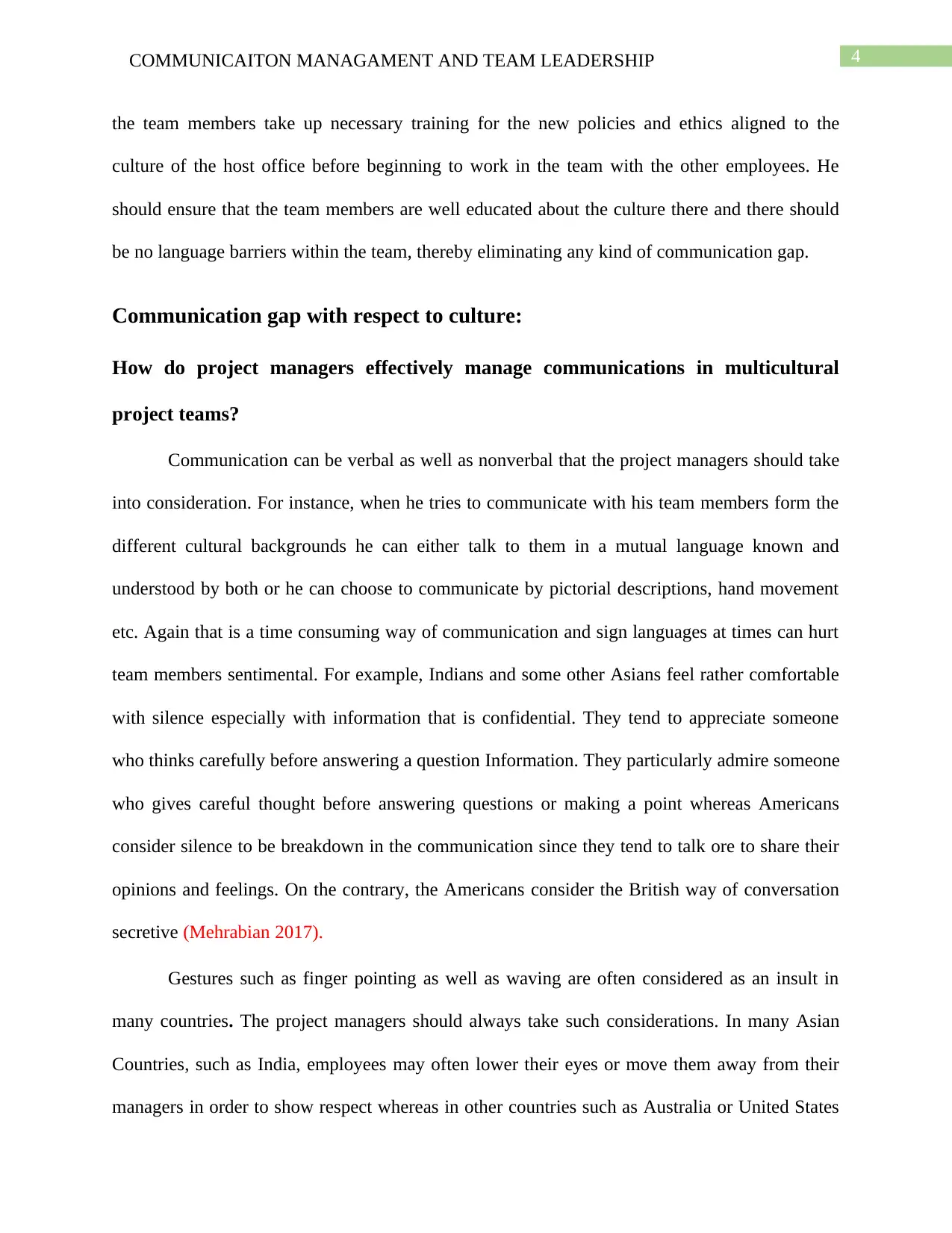
4COMMUNICAITON MANAGAMENT AND TEAM LEADERSHIP
the team members take up necessary training for the new policies and ethics aligned to the
culture of the host office before beginning to work in the team with the other employees. He
should ensure that the team members are well educated about the culture there and there should
be no language barriers within the team, thereby eliminating any kind of communication gap.
Communication gap with respect to culture:
How do project managers effectively manage communications in multicultural
project teams?
Communication can be verbal as well as nonverbal that the project managers should take
into consideration. For instance, when he tries to communicate with his team members form the
different cultural backgrounds he can either talk to them in a mutual language known and
understood by both or he can choose to communicate by pictorial descriptions, hand movement
etc. Again that is a time consuming way of communication and sign languages at times can hurt
team members sentimental. For example, Indians and some other Asians feel rather comfortable
with silence especially with information that is confidential. They tend to appreciate someone
who thinks carefully before answering a question Information. They particularly admire someone
who gives careful thought before answering questions or making a point whereas Americans
consider silence to be breakdown in the communication since they tend to talk ore to share their
opinions and feelings. On the contrary, the Americans consider the British way of conversation
secretive (Mehrabian 2017).
Gestures such as finger pointing as well as waving are often considered as an insult in
many countries. The project managers should always take such considerations. In many Asian
Countries, such as India, employees may often lower their eyes or move them away from their
managers in order to show respect whereas in other countries such as Australia or United States
the team members take up necessary training for the new policies and ethics aligned to the
culture of the host office before beginning to work in the team with the other employees. He
should ensure that the team members are well educated about the culture there and there should
be no language barriers within the team, thereby eliminating any kind of communication gap.
Communication gap with respect to culture:
How do project managers effectively manage communications in multicultural
project teams?
Communication can be verbal as well as nonverbal that the project managers should take
into consideration. For instance, when he tries to communicate with his team members form the
different cultural backgrounds he can either talk to them in a mutual language known and
understood by both or he can choose to communicate by pictorial descriptions, hand movement
etc. Again that is a time consuming way of communication and sign languages at times can hurt
team members sentimental. For example, Indians and some other Asians feel rather comfortable
with silence especially with information that is confidential. They tend to appreciate someone
who thinks carefully before answering a question Information. They particularly admire someone
who gives careful thought before answering questions or making a point whereas Americans
consider silence to be breakdown in the communication since they tend to talk ore to share their
opinions and feelings. On the contrary, the Americans consider the British way of conversation
secretive (Mehrabian 2017).
Gestures such as finger pointing as well as waving are often considered as an insult in
many countries. The project managers should always take such considerations. In many Asian
Countries, such as India, employees may often lower their eyes or move them away from their
managers in order to show respect whereas in other countries such as Australia or United States
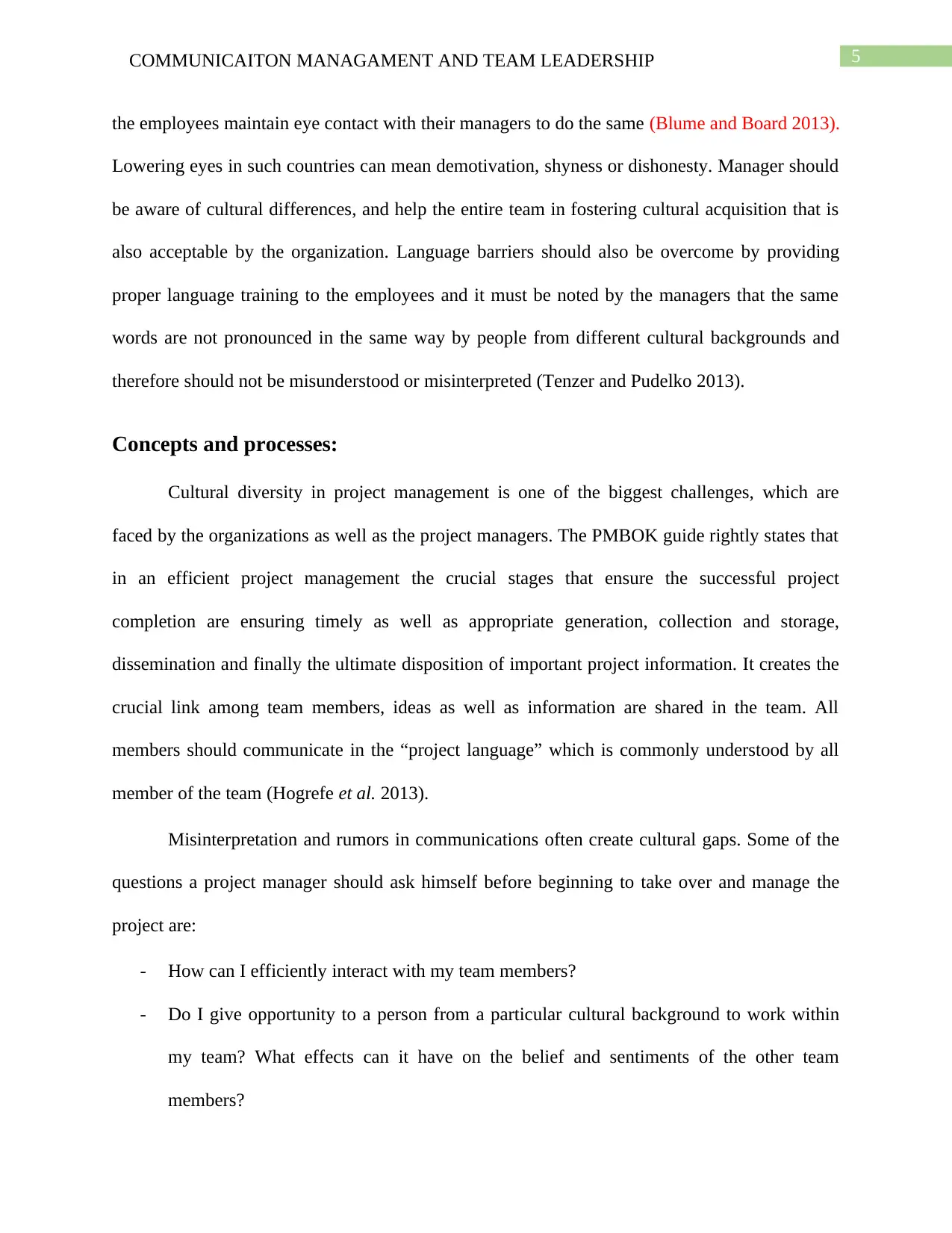
5COMMUNICAITON MANAGAMENT AND TEAM LEADERSHIP
the employees maintain eye contact with their managers to do the same (Blume and Board 2013).
Lowering eyes in such countries can mean demotivation, shyness or dishonesty. Manager should
be aware of cultural differences, and help the entire team in fostering cultural acquisition that is
also acceptable by the organization. Language barriers should also be overcome by providing
proper language training to the employees and it must be noted by the managers that the same
words are not pronounced in the same way by people from different cultural backgrounds and
therefore should not be misunderstood or misinterpreted (Tenzer and Pudelko 2013).
Concepts and processes:
Cultural diversity in project management is one of the biggest challenges, which are
faced by the organizations as well as the project managers. The PMBOK guide rightly states that
in an efficient project management the crucial stages that ensure the successful project
completion are ensuring timely as well as appropriate generation, collection and storage,
dissemination and finally the ultimate disposition of important project information. It creates the
crucial link among team members, ideas as well as information are shared in the team. All
members should communicate in the “project language” which is commonly understood by all
member of the team (Hogrefe et al. 2013).
Misinterpretation and rumors in communications often create cultural gaps. Some of the
questions a project manager should ask himself before beginning to take over and manage the
project are:
- How can I efficiently interact with my team members?
- Do I give opportunity to a person from a particular cultural background to work within
my team? What effects can it have on the belief and sentiments of the other team
members?
the employees maintain eye contact with their managers to do the same (Blume and Board 2013).
Lowering eyes in such countries can mean demotivation, shyness or dishonesty. Manager should
be aware of cultural differences, and help the entire team in fostering cultural acquisition that is
also acceptable by the organization. Language barriers should also be overcome by providing
proper language training to the employees and it must be noted by the managers that the same
words are not pronounced in the same way by people from different cultural backgrounds and
therefore should not be misunderstood or misinterpreted (Tenzer and Pudelko 2013).
Concepts and processes:
Cultural diversity in project management is one of the biggest challenges, which are
faced by the organizations as well as the project managers. The PMBOK guide rightly states that
in an efficient project management the crucial stages that ensure the successful project
completion are ensuring timely as well as appropriate generation, collection and storage,
dissemination and finally the ultimate disposition of important project information. It creates the
crucial link among team members, ideas as well as information are shared in the team. All
members should communicate in the “project language” which is commonly understood by all
member of the team (Hogrefe et al. 2013).
Misinterpretation and rumors in communications often create cultural gaps. Some of the
questions a project manager should ask himself before beginning to take over and manage the
project are:
- How can I efficiently interact with my team members?
- Do I give opportunity to a person from a particular cultural background to work within
my team? What effects can it have on the belief and sentiments of the other team
members?
⊘ This is a preview!⊘
Do you want full access?
Subscribe today to unlock all pages.

Trusted by 1+ million students worldwide
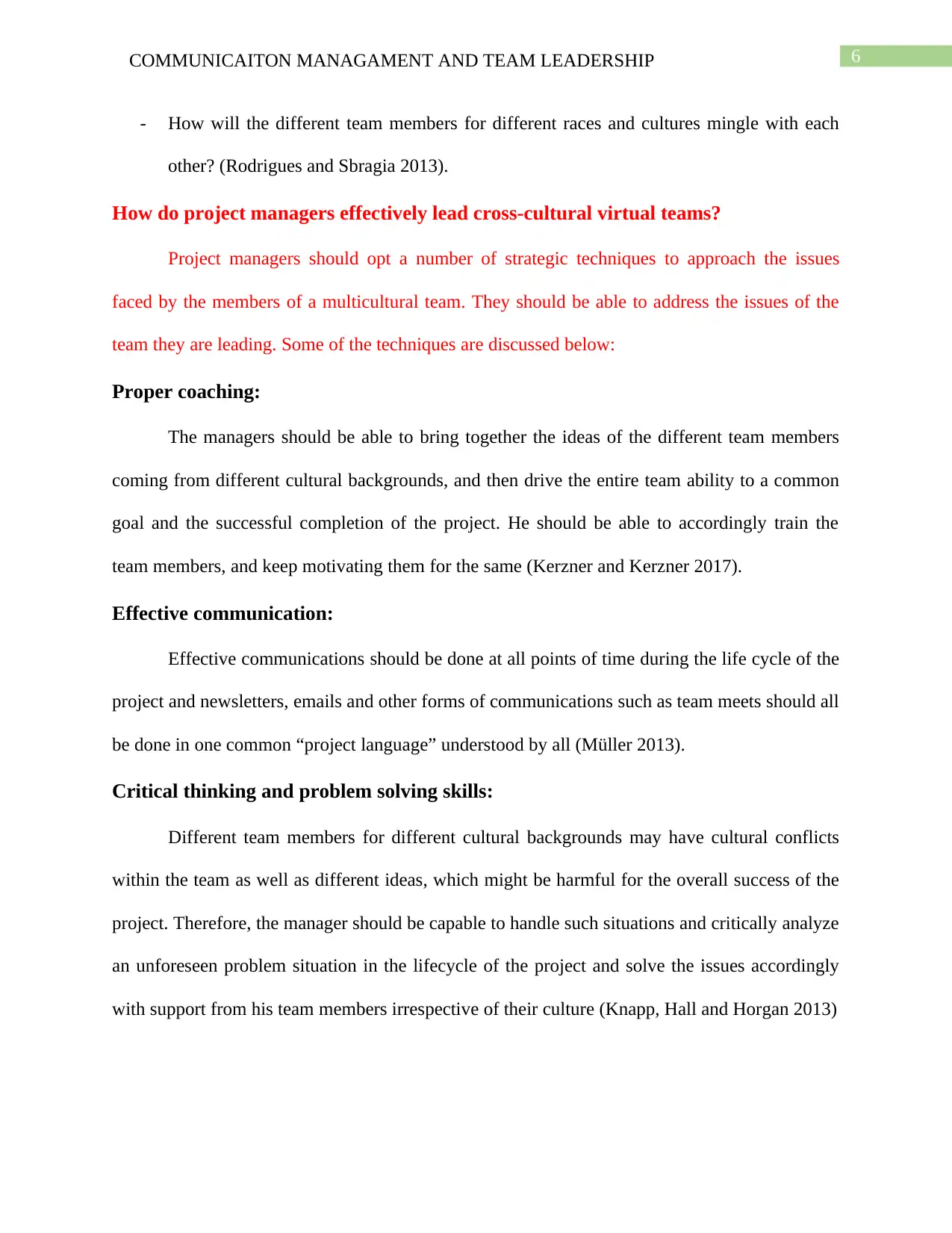
6COMMUNICAITON MANAGAMENT AND TEAM LEADERSHIP
- How will the different team members for different races and cultures mingle with each
other? (Rodrigues and Sbragia 2013).
How do project managers effectively lead cross-cultural virtual teams?
Project managers should opt a number of strategic techniques to approach the issues
faced by the members of a multicultural team. They should be able to address the issues of the
team they are leading. Some of the techniques are discussed below:
Proper coaching:
The managers should be able to bring together the ideas of the different team members
coming from different cultural backgrounds, and then drive the entire team ability to a common
goal and the successful completion of the project. He should be able to accordingly train the
team members, and keep motivating them for the same (Kerzner and Kerzner 2017).
Effective communication:
Effective communications should be done at all points of time during the life cycle of the
project and newsletters, emails and other forms of communications such as team meets should all
be done in one common “project language” understood by all (Müller 2013).
Critical thinking and problem solving skills:
Different team members for different cultural backgrounds may have cultural conflicts
within the team as well as different ideas, which might be harmful for the overall success of the
project. Therefore, the manager should be capable to handle such situations and critically analyze
an unforeseen problem situation in the lifecycle of the project and solve the issues accordingly
with support from his team members irrespective of their culture (Knapp, Hall and Horgan 2013)
- How will the different team members for different races and cultures mingle with each
other? (Rodrigues and Sbragia 2013).
How do project managers effectively lead cross-cultural virtual teams?
Project managers should opt a number of strategic techniques to approach the issues
faced by the members of a multicultural team. They should be able to address the issues of the
team they are leading. Some of the techniques are discussed below:
Proper coaching:
The managers should be able to bring together the ideas of the different team members
coming from different cultural backgrounds, and then drive the entire team ability to a common
goal and the successful completion of the project. He should be able to accordingly train the
team members, and keep motivating them for the same (Kerzner and Kerzner 2017).
Effective communication:
Effective communications should be done at all points of time during the life cycle of the
project and newsletters, emails and other forms of communications such as team meets should all
be done in one common “project language” understood by all (Müller 2013).
Critical thinking and problem solving skills:
Different team members for different cultural backgrounds may have cultural conflicts
within the team as well as different ideas, which might be harmful for the overall success of the
project. Therefore, the manager should be capable to handle such situations and critically analyze
an unforeseen problem situation in the lifecycle of the project and solve the issues accordingly
with support from his team members irrespective of their culture (Knapp, Hall and Horgan 2013)
Paraphrase This Document
Need a fresh take? Get an instant paraphrase of this document with our AI Paraphraser
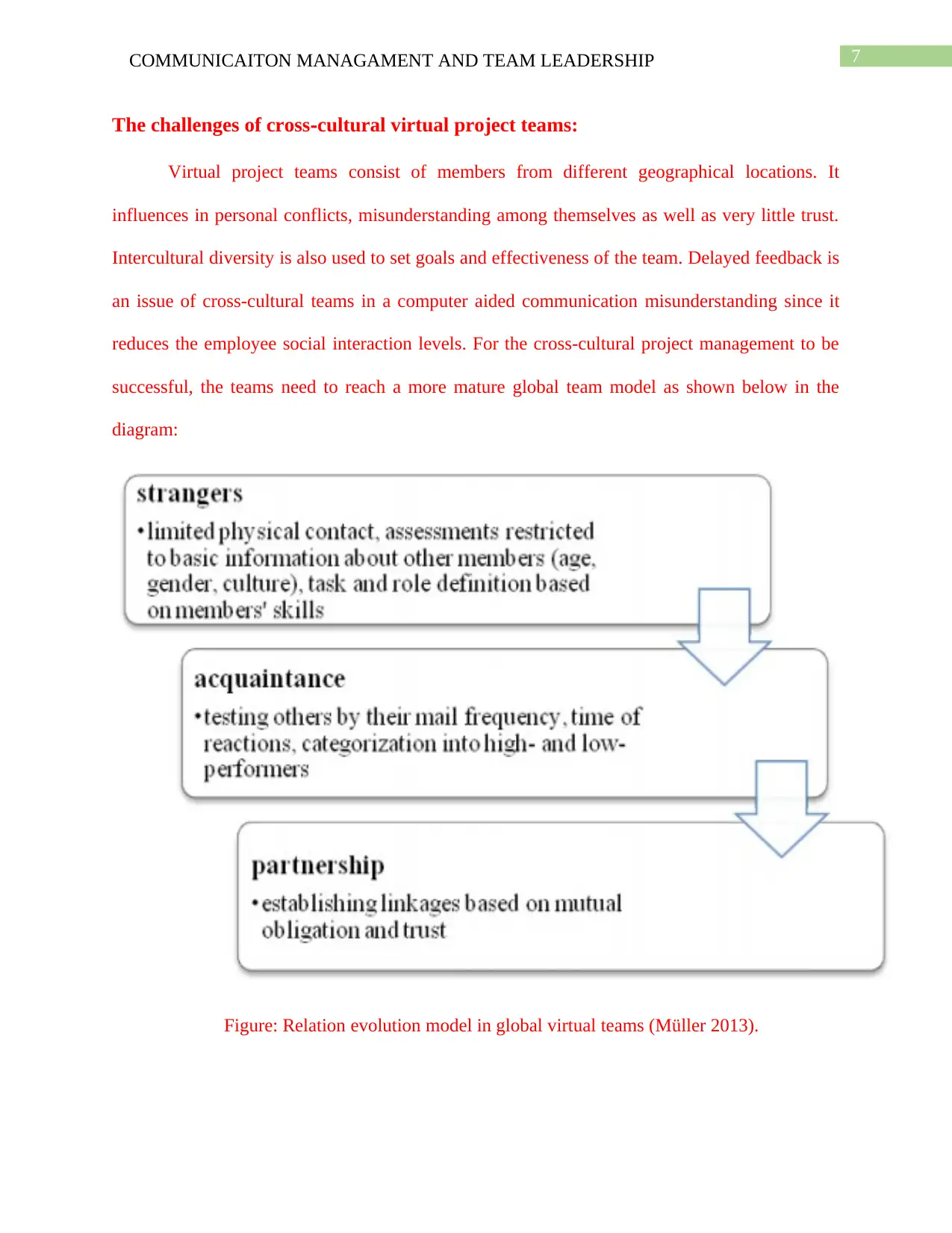
7COMMUNICAITON MANAGAMENT AND TEAM LEADERSHIP
The challenges of cross‐cultural virtual project teams:
Virtual project teams consist of members from different geographical locations. It
influences in personal conflicts, misunderstanding among themselves as well as very little trust.
Intercultural diversity is also used to set goals and effectiveness of the team. Delayed feedback is
an issue of cross-cultural teams in a computer aided communication misunderstanding since it
reduces the employee social interaction levels. For the cross-cultural project management to be
successful, the teams need to reach a more mature global team model as shown below in the
diagram:
Figure: Relation evolution model in global virtual teams (Müller 2013).
The challenges of cross‐cultural virtual project teams:
Virtual project teams consist of members from different geographical locations. It
influences in personal conflicts, misunderstanding among themselves as well as very little trust.
Intercultural diversity is also used to set goals and effectiveness of the team. Delayed feedback is
an issue of cross-cultural teams in a computer aided communication misunderstanding since it
reduces the employee social interaction levels. For the cross-cultural project management to be
successful, the teams need to reach a more mature global team model as shown below in the
diagram:
Figure: Relation evolution model in global virtual teams (Müller 2013).
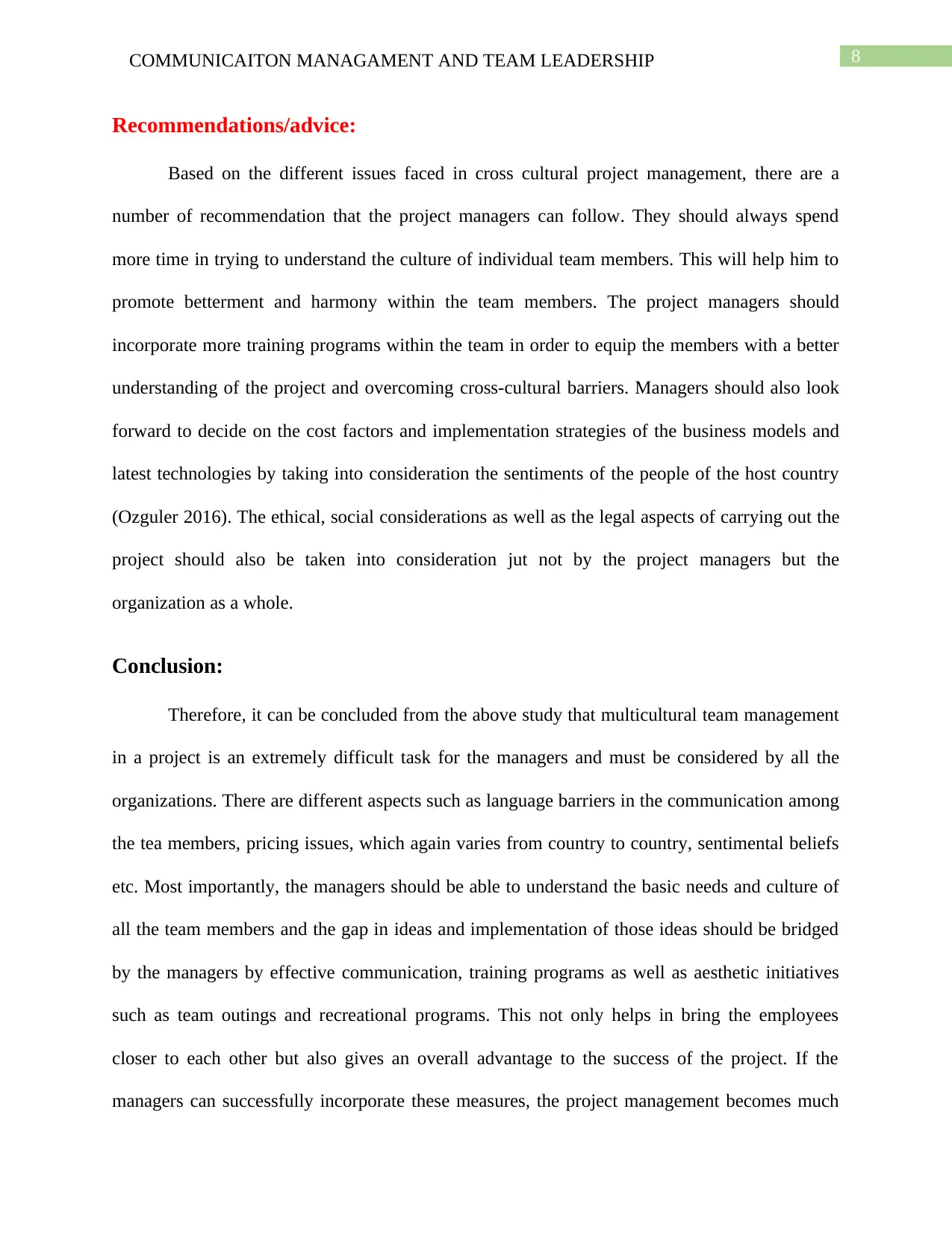
8COMMUNICAITON MANAGAMENT AND TEAM LEADERSHIP
Recommendations/advice:
Based on the different issues faced in cross cultural project management, there are a
number of recommendation that the project managers can follow. They should always spend
more time in trying to understand the culture of individual team members. This will help him to
promote betterment and harmony within the team members. The project managers should
incorporate more training programs within the team in order to equip the members with a better
understanding of the project and overcoming cross-cultural barriers. Managers should also look
forward to decide on the cost factors and implementation strategies of the business models and
latest technologies by taking into consideration the sentiments of the people of the host country
(Ozguler 2016). The ethical, social considerations as well as the legal aspects of carrying out the
project should also be taken into consideration jut not by the project managers but the
organization as a whole.
Conclusion:
Therefore, it can be concluded from the above study that multicultural team management
in a project is an extremely difficult task for the managers and must be considered by all the
organizations. There are different aspects such as language barriers in the communication among
the tea members, pricing issues, which again varies from country to country, sentimental beliefs
etc. Most importantly, the managers should be able to understand the basic needs and culture of
all the team members and the gap in ideas and implementation of those ideas should be bridged
by the managers by effective communication, training programs as well as aesthetic initiatives
such as team outings and recreational programs. This not only helps in bring the employees
closer to each other but also gives an overall advantage to the success of the project. If the
managers can successfully incorporate these measures, the project management becomes much
Recommendations/advice:
Based on the different issues faced in cross cultural project management, there are a
number of recommendation that the project managers can follow. They should always spend
more time in trying to understand the culture of individual team members. This will help him to
promote betterment and harmony within the team members. The project managers should
incorporate more training programs within the team in order to equip the members with a better
understanding of the project and overcoming cross-cultural barriers. Managers should also look
forward to decide on the cost factors and implementation strategies of the business models and
latest technologies by taking into consideration the sentiments of the people of the host country
(Ozguler 2016). The ethical, social considerations as well as the legal aspects of carrying out the
project should also be taken into consideration jut not by the project managers but the
organization as a whole.
Conclusion:
Therefore, it can be concluded from the above study that multicultural team management
in a project is an extremely difficult task for the managers and must be considered by all the
organizations. There are different aspects such as language barriers in the communication among
the tea members, pricing issues, which again varies from country to country, sentimental beliefs
etc. Most importantly, the managers should be able to understand the basic needs and culture of
all the team members and the gap in ideas and implementation of those ideas should be bridged
by the managers by effective communication, training programs as well as aesthetic initiatives
such as team outings and recreational programs. This not only helps in bring the employees
closer to each other but also gives an overall advantage to the success of the project. If the
managers can successfully incorporate these measures, the project management becomes much
⊘ This is a preview!⊘
Do you want full access?
Subscribe today to unlock all pages.

Trusted by 1+ million students worldwide

9COMMUNICAITON MANAGAMENT AND TEAM LEADERSHIP
easier even in a cross-cultural work environment and helps in overall improvement of the project
manager.
easier even in a cross-cultural work environment and helps in overall improvement of the project
manager.
Paraphrase This Document
Need a fresh take? Get an instant paraphrase of this document with our AI Paraphraser
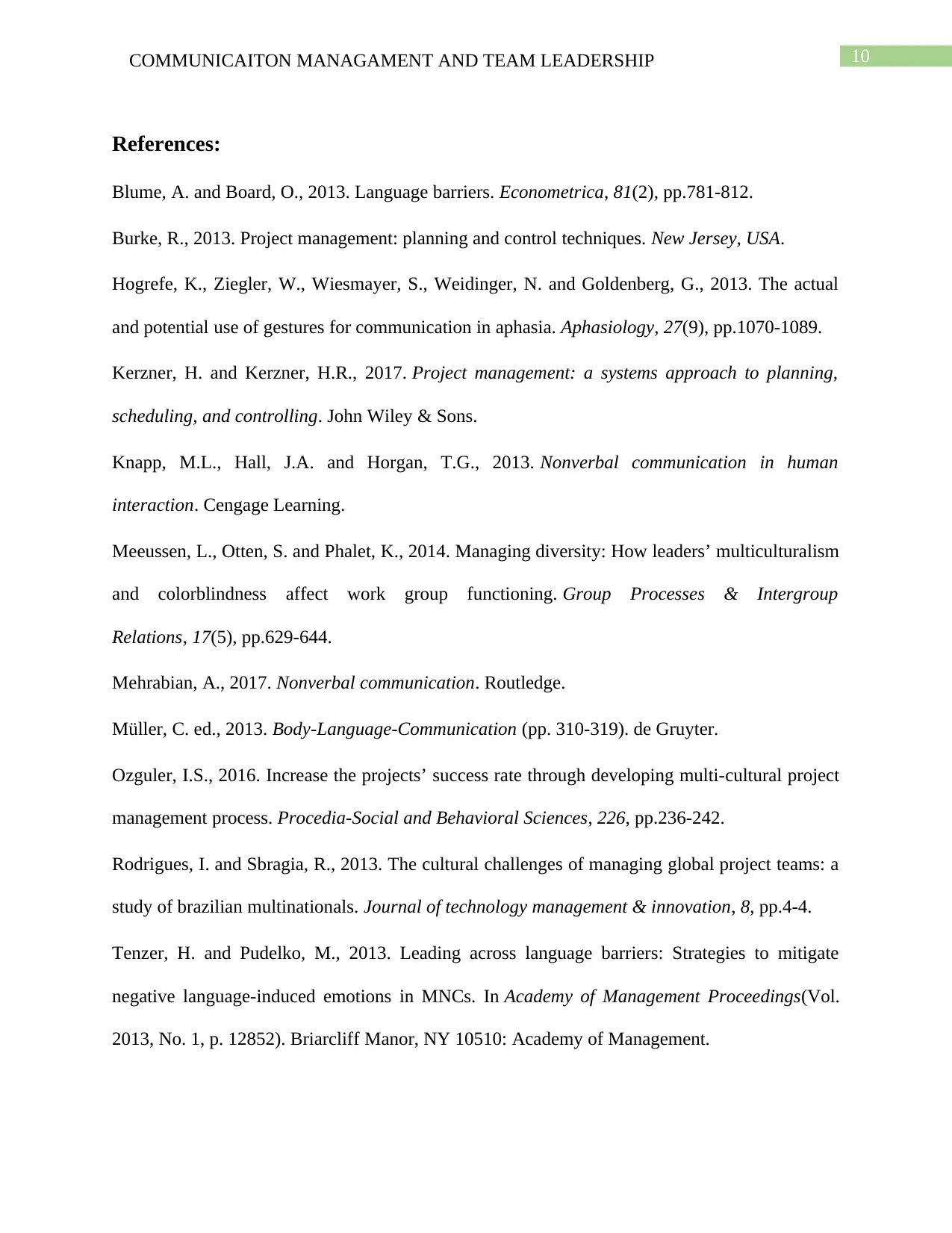
10COMMUNICAITON MANAGAMENT AND TEAM LEADERSHIP
References:
Blume, A. and Board, O., 2013. Language barriers. Econometrica, 81(2), pp.781-812.
Burke, R., 2013. Project management: planning and control techniques. New Jersey, USA.
Hogrefe, K., Ziegler, W., Wiesmayer, S., Weidinger, N. and Goldenberg, G., 2013. The actual
and potential use of gestures for communication in aphasia. Aphasiology, 27(9), pp.1070-1089.
Kerzner, H. and Kerzner, H.R., 2017. Project management: a systems approach to planning,
scheduling, and controlling. John Wiley & Sons.
Knapp, M.L., Hall, J.A. and Horgan, T.G., 2013. Nonverbal communication in human
interaction. Cengage Learning.
Meeussen, L., Otten, S. and Phalet, K., 2014. Managing diversity: How leaders’ multiculturalism
and colorblindness affect work group functioning. Group Processes & Intergroup
Relations, 17(5), pp.629-644.
Mehrabian, A., 2017. Nonverbal communication. Routledge.
Müller, C. ed., 2013. Body-Language-Communication (pp. 310-319). de Gruyter.
Ozguler, I.S., 2016. Increase the projects’ success rate through developing multi-cultural project
management process. Procedia-Social and Behavioral Sciences, 226, pp.236-242.
Rodrigues, I. and Sbragia, R., 2013. The cultural challenges of managing global project teams: a
study of brazilian multinationals. Journal of technology management & innovation, 8, pp.4-4.
Tenzer, H. and Pudelko, M., 2013. Leading across language barriers: Strategies to mitigate
negative language-induced emotions in MNCs. In Academy of Management Proceedings(Vol.
2013, No. 1, p. 12852). Briarcliff Manor, NY 10510: Academy of Management.
References:
Blume, A. and Board, O., 2013. Language barriers. Econometrica, 81(2), pp.781-812.
Burke, R., 2013. Project management: planning and control techniques. New Jersey, USA.
Hogrefe, K., Ziegler, W., Wiesmayer, S., Weidinger, N. and Goldenberg, G., 2013. The actual
and potential use of gestures for communication in aphasia. Aphasiology, 27(9), pp.1070-1089.
Kerzner, H. and Kerzner, H.R., 2017. Project management: a systems approach to planning,
scheduling, and controlling. John Wiley & Sons.
Knapp, M.L., Hall, J.A. and Horgan, T.G., 2013. Nonverbal communication in human
interaction. Cengage Learning.
Meeussen, L., Otten, S. and Phalet, K., 2014. Managing diversity: How leaders’ multiculturalism
and colorblindness affect work group functioning. Group Processes & Intergroup
Relations, 17(5), pp.629-644.
Mehrabian, A., 2017. Nonverbal communication. Routledge.
Müller, C. ed., 2013. Body-Language-Communication (pp. 310-319). de Gruyter.
Ozguler, I.S., 2016. Increase the projects’ success rate through developing multi-cultural project
management process. Procedia-Social and Behavioral Sciences, 226, pp.236-242.
Rodrigues, I. and Sbragia, R., 2013. The cultural challenges of managing global project teams: a
study of brazilian multinationals. Journal of technology management & innovation, 8, pp.4-4.
Tenzer, H. and Pudelko, M., 2013. Leading across language barriers: Strategies to mitigate
negative language-induced emotions in MNCs. In Academy of Management Proceedings(Vol.
2013, No. 1, p. 12852). Briarcliff Manor, NY 10510: Academy of Management.

11COMMUNICAITON MANAGAMENT AND TEAM LEADERSHIP
Tenzer, H., Pudelko, M. and Harzing, A.W., 2014. The impact of language barriers on trust
formation in multinational teams. Journal of International Business Studies, 45(5), pp.508-535.
Tenzer, H., Pudelko, M. and Harzing, A.W., 2014. The impact of language barriers on trust
formation in multinational teams. Journal of International Business Studies, 45(5), pp.508-535.
⊘ This is a preview!⊘
Do you want full access?
Subscribe today to unlock all pages.

Trusted by 1+ million students worldwide
1 out of 12
Related Documents
Your All-in-One AI-Powered Toolkit for Academic Success.
+13062052269
info@desklib.com
Available 24*7 on WhatsApp / Email
![[object Object]](/_next/static/media/star-bottom.7253800d.svg)
Unlock your academic potential
Copyright © 2020–2025 A2Z Services. All Rights Reserved. Developed and managed by ZUCOL.





